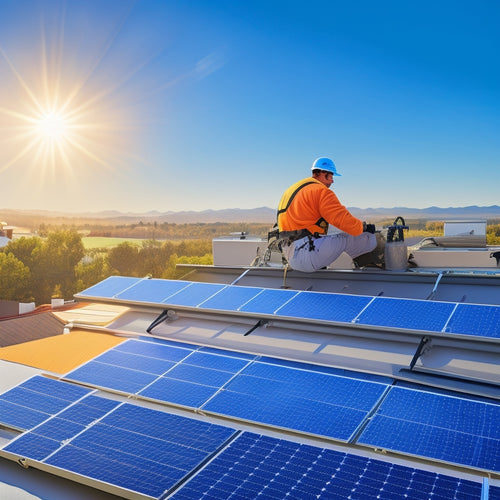
Recycling Old Panels: A Step-by-Step Guide
Share
You're about to start on a thorough recycling process for old panels, where meticulous disassembly, thorough testing, and precise material separation are essential in recovering valuable components and minimizing environmental impact. You'll begin by collecting and disassembling panels, considering their history and environmental implications. Next, you'll test and sort components, utilizing circuit analysis and diagnostic tools to maximize recovery. The process will progress into material shredding and separation, extraction, and refining. As you navigate these steps, you'll uncover the intricate details necessary to produce high-quality, sustainable products – and there's more to discover ahead.
Key Takeaways
• Collect panels from various sources, understanding their history to ensure effective disassembly and minimal environmental impact.
• Test and sort components to maximize recovery, using circuit analysis and diagnostic tools to identify reusable materials.
• Shred panels into raw materials like copper, aluminum, glass, and plastic, optimizing the shredding process and maintaining equipment.
• Extract valuable materials like precious metals and rare earth elements, refining them to produce high-purity materials meeting specifications.
• Ensure recycled materials are compatible with new product design, guaranteeing durability, energy efficiency, and reliability while adhering to safety standards.
Collecting and Disassembling Panels
Gather panels from various sources, including old solar installations, construction sites, and electronic waste recycling facilities, to collect a sizable inventory for disassembly.
You'll want to gather panels with varying histories, as each one tells a story about its past usage and environmental impact. The panels you collect will have unique characteristics, such as different materials, sizes, and conditions, which will influence the disassembly process. Understanding the panel history is vital in determining the most effective disassembly strategy.
As you collect panels, consider the environmental impact of your actions. Recycling old panels reduces electronic waste, conserves natural resources, and decreases the demand for new, resource-intensive panels. Your efforts will contribute to a more sustainable future.
When disassembling the panels, be mindful of the materials you're handling, as they may contain hazardous substances like lead or cadmium. Take necessary precautions to protect yourself and the environment.
Testing and Sorting Components
With the disassembled panels laid out before you, it's time to test and sort the components, separating functional from non-functional parts to maximize the recovery of reusable materials. This vital step guarantees that you identify and isolate components that can be reused or refurbished, reducing electronic waste and conserving natural resources.
Begin by visually inspecting each component for signs of physical damage or wear. Check for burnt or corroded components, which may indicate Component Failure. Perform Circuit Analysis to identify faulty components that can be repaired or replaced. Use multimeters and other diagnostic tools to test the components' electrical properties, such as voltage, current, and resistance.
Sort the components into categories, separating functional from non-functional parts.
Be meticulous in your testing and sorting, as this will directly impact the quality of the recycled materials.
Shredding and Separating Materials
As you start the shredding and separating process, you'll need to understand the material breakdown process, which involves reducing large components into smaller, manageable pieces.
This is typically achieved through the use of shredder machines, whose effectiveness can greatly impact the overall recycling process.
Material Breakdown Process
You initiate the material breakdown process by feeding the old panels into a shredder, which reduces them into smaller fragments, facilitating the separation of constituent materials. This process is vital in creating distinct material streams that can be further processed and recycled. As you shred the panels, you'll notice production bottlenecks emerging, which can be addressed by optimizing the shredding process and adjusting the machine's settings.
| Material Stream | Separation Method |
|---|---|
| Copper Wires | Magnetic Separation |
| Aluminum Frames | Eddy Current Separation |
| Glass Panels | Air Classification |
| Plastic Casings | Optical Sorting |
As you separate the materials, you'll begin to see the distinct streams taking shape. The copper wires, aluminum frames, glass panels, and plastic casings will be separated and prepared for further processing. By improving the material breakdown process, you'll increase the efficiency of your recycling operation and reduce production bottlenecks. Remember to regularly maintain your shredder and adjust its settings to guarantee optimal performance.
Shredder Machine Efficiency
Maximizing the shredder machine's performance is crucial to achieving efficient material breakdown and separation. Even slight adjustments to its settings can significantly impact the quality of the resulting material streams.
You should focus on shredder optimization to minimize energy consumption and maximize output quality. Start by monitoring the machine's energy consumption and adjusting the rotor speed, screen size, and feed rate accordingly. This will help you identify the best settings for your specific material type and desired output.
Extracting Valuable Materials
As you move forward with recycling old panels, you'll need to identify the valuable materials within them.
You'll employ a material identification process to determine the types and quantities of materials present, such as copper, silver, and silicon.
Next, you'll use metal separation techniques to extract these materials, which can then be reused or resold.
Material Identification Process
During the material identification process, recyclers meticulously categorize old panels into distinct material streams to extract valuable components, such as copper, silver, and gold. You'll need to conduct a thorough material analysis to identify the type and quantity of materials present in each panel. This involves examining the panel's composition, including the type of metals, plastics, and other materials used in its construction.
As you dissect the panel, you'll classify each component into specific categories, such as metals, circuit boards, wires, and casings. This component classification is vital in determining the recyclable materials and their potential value.
You'll need to identify the presence of precious metals, such as gold, silver, and copper, as well as other valuable materials like rare earth elements and plastics. By accurately identifying and categorizing these materials, you'll be able to extract the maximum value from the old panels and minimize waste.
Metal Separation Techniques
You'll now employ metal separation techniques to extract the valuable materials identified during the material identification process, such as copper, silver, and gold, from the old panels. This step is essential in recovering the maximum amount of recyclable materials.
To achieve efficient metal separation, you'll utilize various techniques that exploit the unique properties of each material. Here are some key methods:
-
Magnetic separation: Leveraging the magnetic properties of ferrous metals, you'll use magnetic drums or belts to separate iron and steel from non-ferrous metals.
-
Eddy current separation: This technique utilizes the principle of eddy currents to separate non-ferrous metals, such as copper and aluminum, from the waste stream.
-
Density separation: By exploiting the density differences between materials, you'll use air jets or vibrating tables to separate heavier metals from lighter ones.
- Optical sorting: This method employs advanced optical scanners to identify and separate materials based on their color, texture, and reflectivity.
Purifying and Refining Materials
Purifying and refining materials from recycled solar panels involves separating and treating the various components, such as silicon, aluminum, and glass, to produce high-purity materials that can be reused in manufacturing.
As you move forward in the recycling process, you'll need to employ material sourcing strategies to guarantee the quality of your raw materials. This involves sourcing materials from trusted suppliers and implementing quality control measures to detect any impurities.
During the purification process, you'll need to facilitate chemical reactions that break down the materials into their constituent parts. This may involve using acid washes, thermal treatments, or other methods to extract impurities and achieve the desired level of purity.
By controlling the conditions and parameters of these chemical reactions, you can optimize the refining process and produce materials that meet the required specifications.
Producing New Products
With refined materials in hand, you can now manufacture new solar panels or other products that meet industry standards, such as tempered glass, aluminum frames, and silicon wafers. This is where your creativity and expertise in product design come into play. You can create innovative products that not only meet but exceed industry standards, making you a valuable player in the supply chain.
Here are some key considerations for producing new products:
-
Material compatibility: Guarantee that the recycled materials are compatible with the new product design.
-
Product performance: Optimize the product's performance to meet or surpass industry standards.
-
Scalability: Design the production process to be scalable and efficient.
- Sustainability: Consider the environmental impact of the new product and aim to minimize its carbon footprint.
Frequently Asked Questions
Can I Recycle Panels From Old Electronics at Home?
"Did you know that 50 million metric tons of e-waste are generated annually? You can recycle old electronics at home with a dedicated Home Setup, using DIY Tools, and allocating Space for the process, enjoying Personal Benefits while minimizing Environmental Impact."
How Do I Handle Hazardous Materials During Recycling?
When handling hazardous materials during recycling, you'll need to prioritize Toxic Disposal to minimize Environmental Impact; make sure you're equipped with necessary safety gear and follow local regulations to avoid contaminating soil, air, and water.
Are Recycled Materials as Good as Virgin Materials?
"As you ponder the quality of recycled materials, coincidentally, a recent study reveals that recycled materials can be just as reliable as virgin materials, with a lower environmental impact, making them an attractive choice for eco-conscious consumers like you."
Can I Reuse Components From Old Panels in New Projects?
You can breathe new life into old projects by reusing components from retired panels, allowing you to reduce waste and tap into component sourcing savings, while also enjoying design flexibility in your new projects.
Is Recycling Old Panels Economically Viable?
As you weigh the economics, you'll find that recycling old panels can bring significant cost savings, aligning with current market trends that prioritize sustainability and reduced waste, making it a viable option for your business.
Related Posts
-

What You Need to Know About RV Solar Maintenance
When you're out on the road, your RV's solar panel system is your lifeline. But without regular maintenance, you're l...
-

Why Invest in Residential Solar Panel Systems?
By investing in a residential solar panel system, you'll harness renewable energy, reducing your carbon footprint and...
-

3 Essential Steps for Solar Electricity Installation
To guarantee a successful solar electricity installation, you'll need to follow three essential steps. First, assess ...


